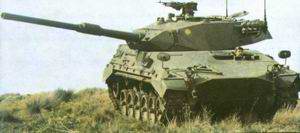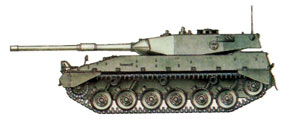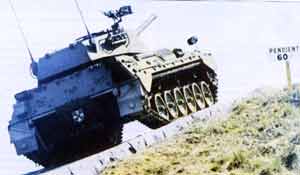| Designation: | TAM |
 |
|---|---|---|
| Manufacturer: | TAMSE Tanqu Argentino Mediano Sociedad Del Estado | |
| Product type: | Armoured Vehicles | |
| Name: | Main battle tank |
The TAM program started in 1973 when the EMGE (Lit: Estado Mayor General del Ejército or General High Command of Argentinian Army) ordered the development of a new medium tank to replace the obsolete M-4 Sherman & Sherman Firefly and a Infantry Combat Vehicle to replace the M-9 Haftracks. The new tank had to be equipped with 105 or 120mm gun, a last generation night vision & fire control system. Additionally, the weight was to be under 35tons, the max speed 80 kph, and the maximum road range to be 500 Km using only internal fuel.
That year, the project was offered to German and French enterprises to help a inexpert argentinian engineers. The Argentinian Army also evaluated two options: the german Leopard 1 and the french AMX-30. The vehicle selected was to be produced in Argentina. The USA also sent a M60A1 for evaluations, but the vehicle was stored because of its high weight and slow speed. Thyssen Henschel present a version of Marder 1 AIFV, which could be produced in two versions: TAM VC with a turret armed with a L-7 105 mm cannon produced under licence from the Germans, late produced in Argentina, and the VCTP, the AIFV version of TAM.
The first four prototypes, two VC and two VCTP, were delivered by Thyssen Henshel in 1976 and were evaluated by argentinian army personnel. Both models were tested under all conditons and terrains available in Argentina, the hot ecuatorial jungles to the North, the high dry deserts of the Northwest, the high mountains of the West and Northwest (6.000 meters over sea level), the plains of the Center and East, and the Mountain and antarctic desert of the South (Patagonia). The tests were succesful and later that year the Frabrica Militares de Río Tercero began producing the first batch of six pre-production vehicles.
In 1978 the TAMSE (Lit; Tanque Argentino Mediano Sociedad del Estado) factory was finished and production of TAM series vehicles: 252 TAM VC and 316 TAM VCTP was started.
In the early 1980's, TAMSE started the development of a mortar carrier of VCTP; the VCTM. It was an entirely argentinian project and 54 vehicles were requested by the Army. By that time, at least 70% of the TAM components were nationally produced.
In the mid 1980's TAMSE produced two new versions of TAM, the MRLS TAM VCLC and the recovery TAM VCRT. The ambulance TAM VCA was abandoned because of the high cost and the cheap options (M-9 Halftrack and M-113) were used instead. The VCLC was developed with israeli assistance and fitted with LAR-160 rocket launcher system. The VCLC fired the CAL 160 rocket (Cohete de Artillería Ligero de 160 mm) and the CAM-350 (Cohete de Artillería Mediano de 350 mm), both local versions of israelís LAR-160 and MAR-350 rocket. The CAL-160 used two 18 rocket containers, and the CAM-350 used four single rocket container.
The VCRT is the tank recovery version of the TAM. The prototype was produced in Argentina, but did not have a good development and was abandoned.
The VCPC command post vehicle was developed and consisted of a basic VCTP chassis without the turret and the rear MG turret, the internal configuration was redesigned, with extra radios, a map board, tactical table, and other specific equipment. This vehicle were accepted into service but only a few were produced.
Late in the 1980's, the Army needed to replace the old AMX-13 Mk. F-3 155 mm artillery vehicles, and TAMSE began to develop an SP version of the TAM. The final option was the italian Palmaria turret and 25 were bought from OTO Breda in Italy. The new TAM VCA Palmaria used a new chassis of 40tons, derived from the TAP project (Tanque Argentino Pesado), which never saw the green light. With seven road wheels and a extensive modifications, the new vehicle was evaluated in early 1990's. The production of these version was undertaken by ASTARSA shipyards from 1998-2000, because TAMSE had closed.
By 1990, Argentinian Army only had 216 TAM VC, 60 TAM VCTP, 36 VCTM and 9 VCPC, when the goverment of Carlos Menem president closed the TAM production facility. In 1994 the Army needed replace their obsolete upgraded Sherman and the goverment authorised the finishing of 46 TAM VC and 40 VCTP in storage in TAMSE. This vehicles were delivered from 1994-1996.
In 2000, the Army asked for two new versions, the VCA Palmaria support vehicle and the Command and Fire Control version. A lot of unfinished TAM VCTP chassis were stored in former TAMSE, now Centro de Recuperación de Vehicular (Lit; Recovery Vehicles Center), and the development was of the VCCDT & VCTM ammunition resupply vehicle was started.
In 2001 the Army started a study to modify the VCRT recovery prototype, this program included a change from the recovery to armoured assault engineers missions, but the political and economical problems again forced a cancellation of this project.
Other projects never seriously developed were the TAM VCLP (Lit; Vehículo de Combate Lanza Puentes or Bridge Launcher Combat Vehicle), VCDA (Lit; VC de Defensa Aerea, or Air Defense CV) with a new turret with twin 30 or 35mm cannons, and the VCLM (Lit; VC Lanza Misiles, or Missile Launcher CV) with Roland 2 or Halcón SAM (Hawk, argentinian local version of Roland 2).
A few years ago, the Argentinian Army tested ERA for the TAM VC, the ERA was of russian and israeli origin, but never entered service due to logistical problems from both suppliers (Russia and Israel).
Sideplates were developed for the TAM and all TAM family are preparated for the installation of them.
In the export market, the TAM were evaluated for:
- Iran (1986 - 1,000 vehicles, never sold, US pressures)
- Iraq (1986 - 400 vehicles, never sold, due to German pressure)
- Peru (1987 - 40 TAM VC & 46 VCTP, cancelled for economicals problems)
- Ecuador (1990 - Cancelled despite TAM winning the competition vs Sk-105A2 and upgraded AMX-13/105)
- Kuwait (1993 - 250 vehicles, never sold, US intervention)
|
||||||||||||||||||||||||||||||||||||||||||||||||||||||||||
|
|||||||||||||||
|
||||||||||||
|
||||||||||||||||||||
All contracts...
 |
 |
 |
 |
 |
 |
 |
 |

